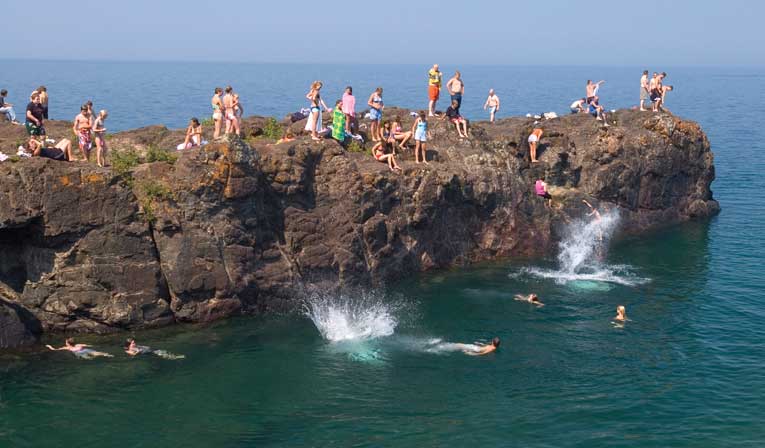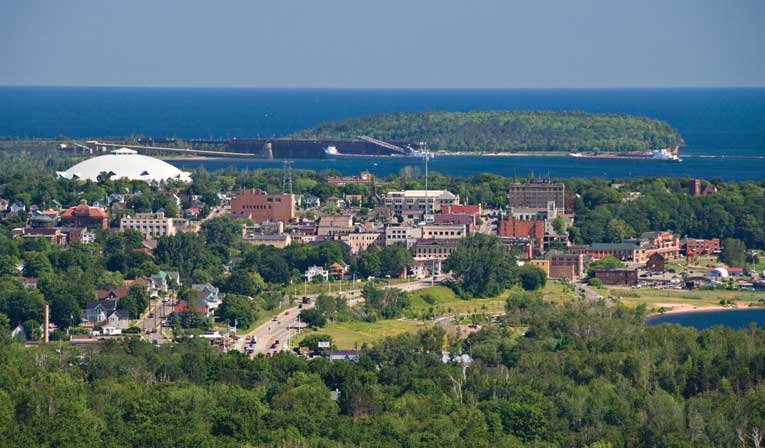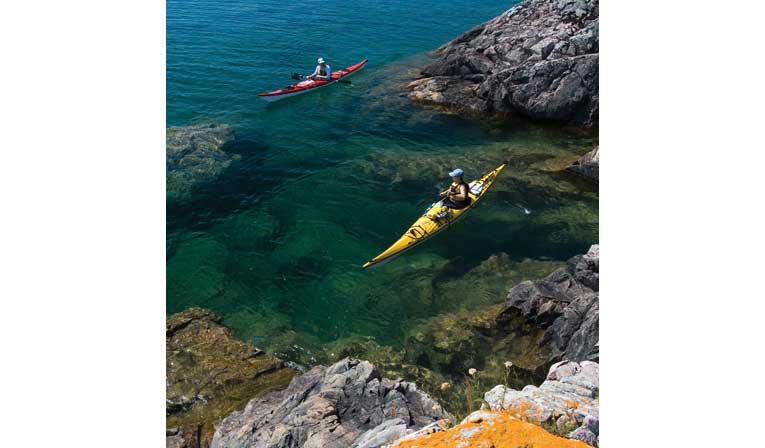Photo by Aaron Peterson
Time-tested tradition makes Marquette, Michigan the place for year-round recreation.
The winter air is electric with dog barks, lake effect snow and the synchronized countdown steaming from the mouths of several thousand hardy spectators braving this frosty February night in Michigan’s Upper Peninsula.
Six bustling blocks of downtown Marquette, the region’s commercial and cultural hub, are closed to traffic, covered with packed snow and lined with cheering fans eager to kick off the UP 200 Sled Dog Championship.
“Three. Two. One!” The crowd roars in unison, sending the first dog team swooshing through a swirl of silver-dollar-sized snowflakes, pools of lamppost light and the sparkle of hundreds of camera flashes. The excitement comes to a peak on the waterfront, where mushers hurtle out of the downtown, drop down a hill to the edge of Lake Superior, and make a sharp turn before being swallowed up by the deep night beyond the city’s glow.
The start of the UP 200 has come to symbolize the Marquette region. Like the dog teams headed out on a 240-mile trial of will and endurance, Marquette is time-tested, practical and full of tradition, but led by a relentless energy and teamwork that have made it a thrilling place to live and visit.
Location, Location, Location
Marquette is a Lake Superior harbor town in the central Upper Peninsula of Michigan. The Upper Peninsula (just call it the U.P., or Yoop) is a sparsely populated region historically important for its timber and minerals, but more and more is securing its future through tourism and outdoor recreation. The U.P. contains almost a quarter of Michigan’s landmass, but only around three percent of its population. The fact that Marquette, at only around 20,000 souls, is the largest American city in a four-hour radius should tell you something about one of the region’s greatest assets: Elbow room.
Marquette’s downtown gazes east over its namesake bay on Lake Superior. To the north and west, the shoreline slices away in a series of small sandy coves punctuated by dark rocky points and red sandstone shelves. The shoreline is thickly forested, and only a few homes impede on the wild coast for about 30 miles to the tiny harbor hamlet of Big Bay. This area offers the combination of adventure, friendliness and reliable snow (200 inches per year) that snowmobilers love.
A visit to Big Bay isn’t complete without a stop at Cram’s General Store. This family-owned and -operated grocery and hardware store caters to snowmobilers in winter and locals and tourists year round.
To Marquette’s east, long stretches of beach are interrupted now and again by eroded sandstone points before finally falling at the feet of the brightly striped 200-foot-high cliffs of Pictured Rocks National Lakeshore beginning in Munising.
Inland, visitors will find deep forests, numerous lakes and a growing network of hiking and biking trails spiderwebbing through the largely public hinterlands. Miles of productive trout streams plummet through the rolling remains of the ancient Huron Mountains. The geology of these Precambrian peaks is valued for its scenic beauty on the surface and vast mineral wealth beneath. This fact gave rise to the region’s economy, and today forces a tough conversation about the future.

Photo by Aaron Peterson
Marquette Information
 EPIC EVENTS
EPIC EVENTS
UP 200 Sled Dog Championship, February Downtown Marquette start and a 240-mile roundtrip race to qualify for the Iditarod
www.up200.org
Marquette Area Blues Fest, August. Regional and national acts bring the blues to the shore of Superior
www.marquetteareabluessociety.com
Ore to Shore Mountain Bike Epic, August. Join more than 2,000 cyclists for your choice of a 48- or 24-mile mountain bike race
www.oretoshore.com
Art on the Rocks, July. 180 regional and national artists
www.artontherocks.org
International Food Fest and Fourth of July Food Festival, Mattson Park with downtown parade and fireworks over the harbor
www.marquettecountry.org
MUSEUMS
Marquette Regional History Museum
Downtown Marquette
www.marquettecohistory.org
Michigan Iron Industry Museum
US 41/M-28 between Marquette and Negaunee
www.michigan.gov/ironindustrymuseum
Marquette Maritime Museum and Lighthouse
Lakeshore Blvd., Marquette
www.mqtmaritimemuseum.com
REALTY
Statewide Real Estate of Houghton
Kevin Liimatta, Broker
www.statewideofhoughton.com
906-482-6955 x. 14
Photo by Aaron Peterson
Photo by Aaron Peterson
Iron Rangers
In 1844 nearly pure deposits of iron ore were discovered about 10 miles inland from Marquette, near the present day cities of Negaunee and Ishpeming. Marquette’s harbor, protected from the north and west, was the natural choice to ship the ore to industrial Great Lakes cities to the south.
The early days of iron mining and shipping were as hard as the minerals they involved. Ore was dug and loaded by hand, carted overland with mules, then unloaded onto docks by hand and reloaded by wheelbarrow onto the decks of schooners — one load at a time. It was slow, back breaking work, but the ore deposits were rich along what became known as the Marquette Iron Range, and demand was high as the nation’s industrial cities boomed.
An influx of immigrants from diverse regions like Italy, Cornwall and Finland, along with geographic isolation, harsh winter weather and tough working conditions in the mines combined to create a unique regional culture. Today that culture is summed up in the term “Yooper.” Sometimes used to deride U.P. residents as yokels, it’s more often embraced by most of the population and used as a term of endearment to mean someone who is tough, practical, maybe a little goofy, but definitely NOT from the urban areas to the south.
In 1855 the locks at Sault Ste. Marie, Michigan were completed, easing navigation between Lake Superior and Lake Huron, and revolutionizing the flow of ore from the Marquette Range. A railroad now linked the mines with Marquette’s new invention, the pocket dock. Railcars full of ore would travel on an elevated trestle out over the lake and dump their cargo down chutes into the holds of more specialized ore hauling ships.
In this way iron flowed out of Marquette and into America where it helped the Union win the Civil War, fueled the auto industry and built the skyscrapers of the nation’s largest cities. The Marquette region’s iron ore mining and shipping industries were so crucial that K.I. Sawyer Air Force Base was located 20 miles south of the city to guard against Soviet attack during the Cold War.
At one point around 200 mines operated along the nearly 60 miles of the Marquette Range. The elite families of Marquette industry thrived, amassing mind boggling fortunes from timber, iron and banking, the effects of which are still seen in the city’s downtown architecture.
However, economies built on extractive industry are volatile, natural resources are finite, and eventually the iron mining boom days dwindled, as did the region’s population. The air base is gone (transformed into the regional civilian airport) but mining at two open pit operations near Ishpeming still employ around 1,500 workers. In 2011, 4.6 million tons of ore was shipped from the remaining operational dock in Marquette’s Upper Harbor. While iron mining has been the key player in the region’s history, and to a large part still underpins the local economy, today the 9,000-student Northern Michigan University, a 300-bed regional hospital system and a mix of light industry and service sector jobs mesh with an explosion in active travel tourism to fuel the region’s changing identity.
However, recent discoveries of small, highly valuable bodies of copper and nickel northwest of Marquette may lead to a new mining revolution in the region. The announcement of the new discovery has forced the community, and state legislature, to debate the merits of new mines versus the possible contamination of area streams or even Lake Superior. In 2011, construction of a new copper and nickel mine began about 40 miles northwest of Marquette, with the potential for several additional mines rumored in the coming years. Mining companies promise much needed good jobs, for the 10 to 15 year life of the mines, while critics warn of the potential for long-term environmental damage that would threaten the tourism industry and quality of life in the region.
Downtown
Any visitor to Marquette is sure to notice two things: The abundance of public waterfront and the signature red sandstone architecture of the downtown. Historically the lifeblood of Marquette has flowed through its two downtown arteries: Front and Washington streets. They meet at the appropriately red heart of the downtown shopping district. In an effort to avoid the devastation wrought by fires in the town’s early years, many of today’s downtown buildings were built of locally quarried sandstone. The chocolately browns, deep reds and creamy swirls in the hefty stone blocks give Marquette’s downtown a solid feel.
Most notable among these is the unique Savings Bank building at the corner of Front and Washington. The tall, narrow former bank building boasts a pointy, functioning clock tower at its peak, a landmark visible from all over the city’s downtown and scene of the annual New Year’s Eve ball drop ceremony.
Perched atop the hill up Front Street one can’t help but notice the towering Landmark Inn, a fully restored boutique hotel that’s hosted the likes of Amelia Earhart, Louis Armstrong and The Rolling Stones since opening in the 1930s. The Landmark is posh but approachable, and it’s worth visiting even if just for a stroll through the marble and mahogany lobby or for a pint in the English-style Northland Pub on the main floor. Take the elevator to the North Star Lounge at the top floor, enjoy a cocktail and take in the panoramic view of the harbor and downtown below. Staying or dining at the Landmark is probably the best way to imagine what it was like to be a timber baron on the Marquette Range at the turn of the last century.
If you’re at the Landmark, then you’re in good company. Across the street is Marquette’s award winning Peter White Library, named for one of its founders and best patrons. Take a stroll or drive along nearby Ridge Street to witness the sprawling mansions built by Marquette’s earliest millionaires.
In the past decade, Marquette’s downtown has gone from static and nearly abandoned, to energized and bustling. Several large department store buildings have been sectioned into smaller spaces and now boast regional art and gift shops, jewelry stores, clothing boutiques and restaurants.
A not-to-be-missed downtown dining establishment is the upscale Elizabeth’s Chop House on the waterfront, with fabulous views of Lake Superior. Kick back and enjoy a melt-in-your-mouth steak or fresh seafood in a fun and relaxing atmosphere. Come as you are and be treated like royalty.
Other area restaurants include the warm and charming Vierling Pub and Marquette Harbor Brewery (whitefish!) and the sprawling UpFront & Company in a wonderfully renovated former hotel (pizza and calzones!). Nearby, the Marquette Food Co-op is revolutionizing the local food scene by offering many seasonal and locally grown foods. Next door, Marquette Baking Company has fabulous fresh bread, while up the street Dead River Coffee Roasters offers an eclectic atmosphere and java roasted on site.
Be sure to check out Doncker’s, an old-time candy store and lunch counter in business since 1896. President Barack Obama paid the store a visit during his February 2011 trip to Northern Michigan University.
The downtown is thriving, filled with historic architecture and a youthful vibe, but the best part is it’s all within walking and biking distance of the reclaimed Lake Superior waterfront beaches, parks and marina. The boating life is the good life in Marquette.

Photo by Aaron Peterson
Simply Superior
The heyday of shipping and water-based commerce has passed for Marquette’s Lower Harbor. The waterfront once bristled with docks and shacks, garbage and industrial fallout. Today it is a sparkling green and blue canvas that the city paints its social life on. A once sooty coal dock is now the massive green space of Mattson Lower Harbor Park, a large open space that lends itself to events like the nationally acclaimed Art on the Rocks art festival, the Seafood Fest, International Food Fest and the Marquette Blues Fest.
The Cinder Pond Marina (101 slips), one of two municipal marinas, is located near the park, in the hulking shadow of the abandoned iron ore loading dock still projecting out into the harbor. Some see the ore dock as an eyesore, while others embrace it as a piece of giant industrial art and a cultural relic of the working waterfront.
Nearby, a former rail yard, once known for its environmental contamination and dubious distinction as a place for railroad hobos, has been reborn as Founder’s Landing, a mixed-use development of green space, housing, a hotel and shops. In an impressive display of forethought and smart growth, the entire waterfront remains public, with numerous improvements like a multiuse path, bridges and the restoration of a small babbling stream.
Other attractions convenient to the marina include the Lake Superior Theatre, housed in the Frazier family’s boathouse. It’s an informal affair right on the water, often offering a taste of local history and culture in its performances. The Marquette Maritime museum is also located nearby, adjacent to the new U.S. Coast Guard facility. The museum is your gateway to a tour of the charming red Marquette Lighthouse that sits like a little Monopoly house on a rocky point just north of the Lower Harbor.
A bike and walking path ties the city together, from its scenic lakeshore to its commercial and residential interior. Bikes can be rented at Lakeshore Bike shop, just north of the Maritime Museum on Lakeshore Boulevard.
Presque Isle
At the northern end of the city’s waterfront lies the Upper Harbor, home to an active iron ore loading dock, the Presque Isle Marina (97 slips) and the one-of-a-kind Presque Isle Park.
Presque Isle Park is a 323-acre city park located on an oval mound of rocky land jutting out into Lake Superior. The name means “almost an island” in French, and though firmly connected to the mainland by a road today, it is still locally known as “the island.”
The park is open year round offering hiking in summer and skiing and snowshoeing in the winter on a network of trails. A swimming beach doubles as a launch site for sea kayakers. There’s also a boat launch and marina, as well as a wooden band shell, concessions stand, wetlands nature walk and long breakwater that’s home to the Upper Harbor Lighthouse. A popular two-mile paved vehicle and bike loop follows the park’s outer perimeter with pullouts at sites like an ancient lava flow called Black Rocks (popular cliff jumping spot) and Sunset Point, a dizzying cliff overlook and the grave of an Ojibwa chief. The park has a resident deer herd and recently also has been home to a few moose.
The Presque Isle Marina is removed from the hustle of the downtown, but also the convenience it offers. However it grants immediate access to Presque Isle Park and the ability to watch large freighters take on loads of ore at the railroad dock right from your boat. The nearby Presque Isle Station gift shops also offer an eclectic collection of regional artwork and gifts housed in a former railroad station. It’s about five miles from the Presque Isle area to the Lower Harbor, a pleasant way to take in the entire waterfront by foot or bike along the city’s multiuse path.
A Trails Town
In recent years Marquette has increasingly become know as a hotspot for active outdoors people. Accolades continue to flow from publications like Bike Magazine, which named it as one of the top places to live and ride for mountain bikers. Outdoor Life placed it in the top ten of the top 100 outdoor towns in the country — two years in a row. The list goes on, and for good reason. The weather and geology of the area — rolling hills, wild shorelines, quiet lakes and abundant snowfall — cries out to those who demand close contact with nature in their everyday lives.
Much of the credit for this goes to the non-profit Noquemanon Trails Network, whose volunteers and staff have worked tirelessly to develop and promote mountain biking and Nordic skiing trails in the region. There’s even a paddling trail, the Hiawatha Water Trail, that makes it easy for visitors to find launch and camping sites along the beautiful and remote Lake Superior shoreline.
Marquette is without a doubt a cycling town. There’s an active BMX group, organized weekly mountain bike rides, road biking clubs and even downhill bikers and winter snow bikers. Events like the Superior Bike Fest, a weekend-long compilation of downhill, cross-country mountain bike and road cycling events, and the Ore to Shore Mountain Bike Epic, a 48-mile point-to-point race starting in Negaunee (the ore) and ending in Marquette (the shore) help fuel the cycling culture and draw thousands to the region to participate.
In winter Marquette Mountain ski area, located within the city limits, takes advantage of the region’s 200-inch average snowfall. On the Nordic trails that snow is packed and meticulously groomed for events like the Noquemanon Ski Marathon, a weekend of ski and snowshoe races that draws thousands to the city’s snowy backyard.
North of Marquette, trails abound at places like Sugarloaf Mountain, a peak in the Huron Mountains offering overlooks of the islands and bays of Lake Superior. Hogback Mountain is nearby and calls out to the explorer in all of us to reach its summit, especially at the peak of fall color in early October. Harlow Lake in the Escanaba River State Forest offers days of exploration along the rocky ridges ringing its quiet waters. Hugging the Lake Superior Shore, Little Presque Isle and Wetmore Landing are often inexplicably empty of people, even though located less than 10 miles outside the largest city in the region.
So many like-minded people in such a small town has created a warm, authentic outdoors culture in the region, and it’s reflected in the city’s commerce. There are four bike shops, three ski shops, a skate, surf and snowboard shop, and now a used gear exchange as well.
In 2010, two avid cyclists took their passion for homebrewing “legit” and founded Blackrocks Brewery, a self-described nano-brewery in an old foursquare house. They are only open a few days a week, make uber high-quality beer in tiny batches (it often sells out) but have catalyzed a new chapter in a story that has Marquette as the cool main character.
Aaron Peterson is a writer and photographer based in Michigan’s Upper Peninsula. For more of his work, visit aaronpeterson.net.





